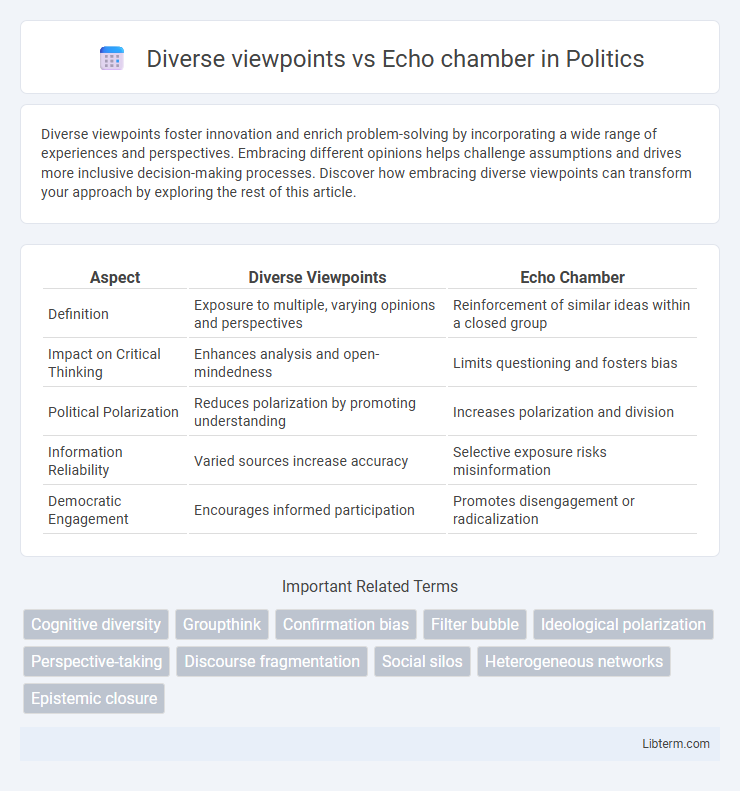Diverse viewpoints foster innovation and enrich problem-solving by incorporating a wide range of experiences and perspectives. Embracing different opinions helps challenge assumptions and drives more inclusive decision-making processes. Discover how embracing diverse viewpoints can transform your approach by exploring the rest of this article.
Table of Comparison
| Aspect | Diverse Viewpoints | Echo Chamber |
|---|---|---|
| Definition | Exposure to multiple, varying opinions and perspectives | Reinforcement of similar ideas within a closed group |
| Impact on Critical Thinking | Enhances analysis and open-mindedness | Limits questioning and fosters bias |
| Political Polarization | Reduces polarization by promoting understanding | Increases polarization and division |
| Information Reliability | Varied sources increase accuracy | Selective exposure risks misinformation |
| Democratic Engagement | Encourages informed participation | Promotes disengagement or radicalization |
Understanding Diverse Viewpoints vs Echo Chambers
Understanding diverse viewpoints involves engaging with a wide range of perspectives, which enhances critical thinking and fosters innovation. Echo chambers limit exposure to differing opinions, reinforcing biases and reducing the ability to evaluate information objectively. Embracing diverse viewpoints is essential for informed decision-making and cultivating empathy in social interactions.
The Psychology Behind Echo Chambers
Echo chambers occur when individuals selectively expose themselves to information that reinforces their existing beliefs, leading to confirmation bias and cognitive dissonance reduction. The psychological need for social belonging and identity protection drives people to prioritize homogenous viewpoints, reducing exposure to diverse perspectives. This behavior limits critical thinking and fosters polarization by creating insulated social environments resistant to conflicting evidence.
Benefits of Embracing Diverse Perspectives
Embracing diverse perspectives fosters innovation and critical thinking by exposing individuals to varied ideas and experiences, thereby reducing cognitive biases and enhancing problem-solving skills. It cultivates empathy and cultural awareness, promoting inclusive decision-making and stronger collaboration in both social and professional environments. Engaging with diverse viewpoints challenges assumptions and prevents the formation of echo chambers, leading to more balanced and informed conclusions.
Risks and Consequences of Echo Chambers
Echo chambers amplify confirmation bias, limiting exposure to diverse viewpoints and reinforcing polarized beliefs. The lack of contrasting opinions fosters misinformation and reduces critical thinking, leading to social fragmentation and decreased empathy. These dynamics increase the risk of radicalization and hinder constructive dialogue in democratic societies.
Social Media’s Role in Promoting Echo Chambers
Social media algorithms prioritize content that aligns with users' existing beliefs, reinforcing filter bubbles and creating echo chambers that limit exposure to diverse viewpoints. This selective exposure shapes public opinion by amplifying homogeneous perspectives while marginalizing dissenting voices. The resulting polarization undermines meaningful dialogue and promotes ideological segregation across digital communities.
Impact of Algorithms on Information Exposure
Algorithms shape information exposure by prioritizing content based on user behavior, often reinforcing existing beliefs and contributing to echo chambers. This filtering effect reduces exposure to diverse viewpoints, limiting critical thinking and increasing polarization. Understanding and redesigning these algorithms is essential to promote balanced information consumption and foster healthier public discourse.
Strategies to Foster Open Dialogue
Encouraging diverse viewpoints requires creating safe spaces where individuals feel respected and heard, promoting active listening techniques that validate different perspectives. Implementing structured dialogue frameworks such as Socratic questioning or moderated discussions prevents echo chambers by challenging assumptions and reducing bias. Incorporating interdisciplinary collaboration and culturally responsive facilitation enhances critical thinking and empathy, fostering an environment where open dialogue thrives.
Real-World Examples: Diverse Viewpoints in Action
Diverse viewpoints foster innovation and problem-solving, as seen in companies like Google and Microsoft, where cross-functional teams drive breakthrough technologies. In contrast, echo chambers--common in social media algorithms--limit exposure to differing ideas, reinforcing biases and polarizing communities. Real-world examples highlight that organizations embracing diversity in perspectives outperform those trapped in homogeneous thought environments.
Overcoming Confirmation Bias Online
Overcoming confirmation bias online requires actively seeking diverse viewpoints beyond personal beliefs or social media bubbles to challenge pre-existing opinions. Engaging with credible sources presenting alternative perspectives fosters critical thinking and reduces the risk of echo chambers reinforcing misinformation. Utilizing digital literacy tools and algorithms designed to expose users to varied content can promote balanced understanding and healthier online discourse.
Building Resilient, Inclusive Communities
Diverse viewpoints foster critical thinking and innovation, essential for building resilient, inclusive communities that can adapt to changing circumstances. Exposure to multiple perspectives combats the formation of echo chambers, which often reinforce biases and limit social cohesion. Encouraging open dialogue and inclusivity enhances community resilience by promoting mutual understanding and collaborative problem-solving.
Diverse viewpoints Infographic

 libterm.com
libterm.com